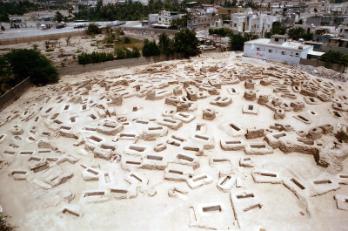Contact Center
.
Shakhura Tylos Necropolis
The archaeological site of Shakhura, today protected by the Bahrain Authority for Culture and Antiquities, is located northwest of the village of the same name, about 700m to the south of Budaiya Highway. It presently occupies about 4 hectares, including several low hills covering unexcavated cemeteries from the Tylos period (c. 150 BCE to 250 CE). A group of excavated underground graves of the Late Dilmun period (c. 900-800 BCE) also appear in the southeastern sector of the site. Currently, fifteen Tylos burial mounds can be seen, of various sizes and heights and irregularly distributed in the archaeological area. None of the ones which still survivehas been excavated
However, the full extent of the archaeological site has been significantly diminished over the last thirty years, and many other Tylos cemeteries, excavated from 1969 in the vicinity of this protected sector, are no longer visible. The Shakhura area, together with the neighbouring ones of Abu Saiba and Maqaba, gathered more than 30 Tylos separate cemeteries, showing that this particular sector of Bahrain’s main island was densely occupied about 2000 years ago. Some of the Tylos cemeteries excavated by the Directorate of Archaeology in 1992-93 (Mound 1) and 1996-97 (Mound A1) were of significant extent and height (up to 5m) and included several hundred individual adult graves, either juxtaposed or superimposed, as well as many children’s burials in earthenware jars.
Generally, these cemeteries remained in use for several centuries. Often, there was an elaborate grave at the heart of the graveyard over which a particularly imposing mass of earth had been placed. The later burials then formed concentric circles around this central burial, each with a much lower sandy mound. This progressive accumulation resulted in merging all these sandy mounds to create a single hillock, which remains today the main characteristic element of Tylos cemeteries in Bahrain’s landscape.
The graves discovered at Shakhura site were among the richest found in Bahrain, although many had been heavily plundered during Antiquity. The tombs were richly furnished with objects intended to help the dead to make their journey to the afterlife in the best conditions. Such equipment included glazed ceramic vases (probably filled with food and drink), glass perfume vessels, stone and wood containers, terracotta or plaster ritual figurines, with finely made jewellery adorning the bodies. Shakhura site also yielded the most impressive funerary stone stelae bearing a physical representation of the deceased. All these discoveries are presently kept or on display at the Bahrain National Museum.










